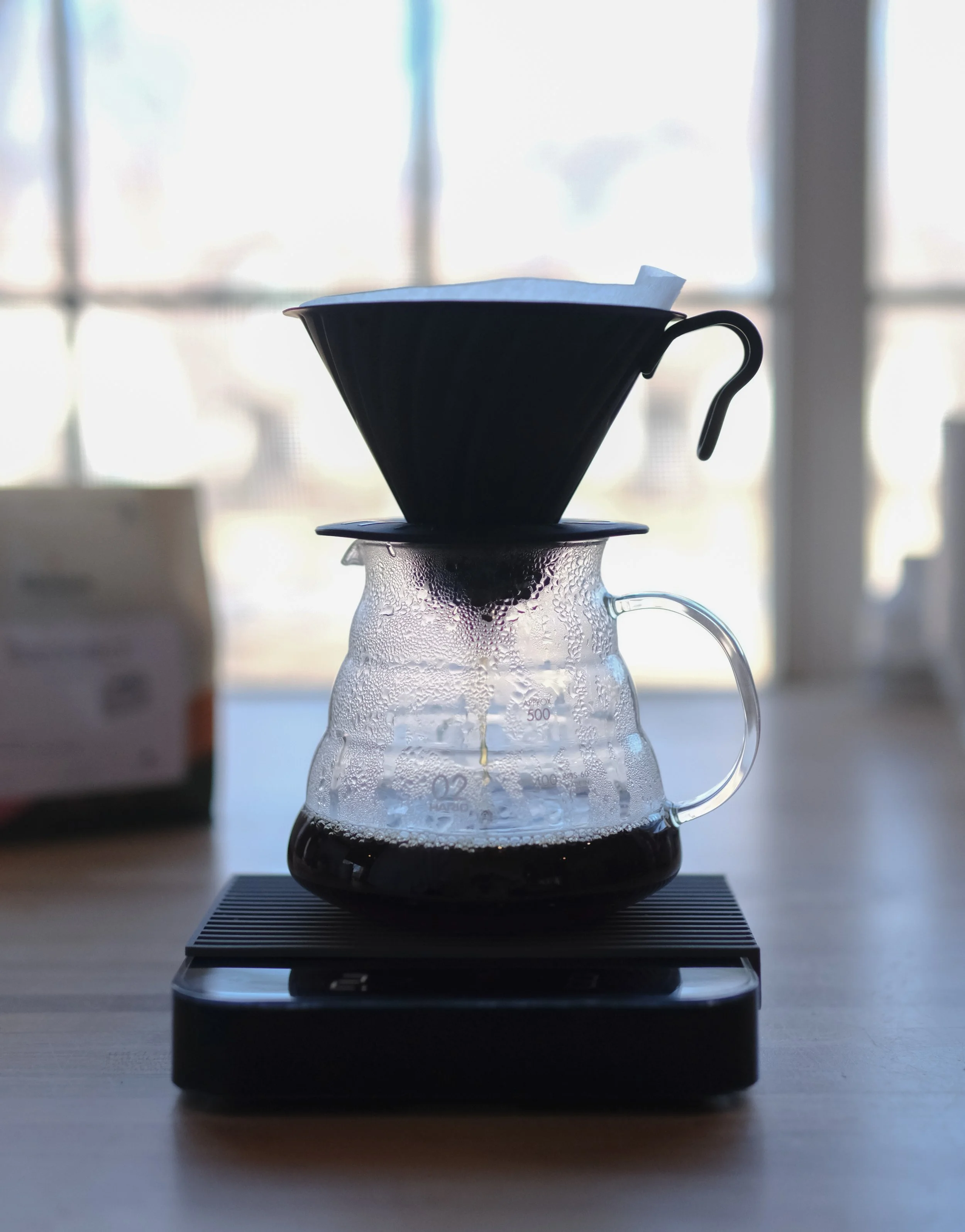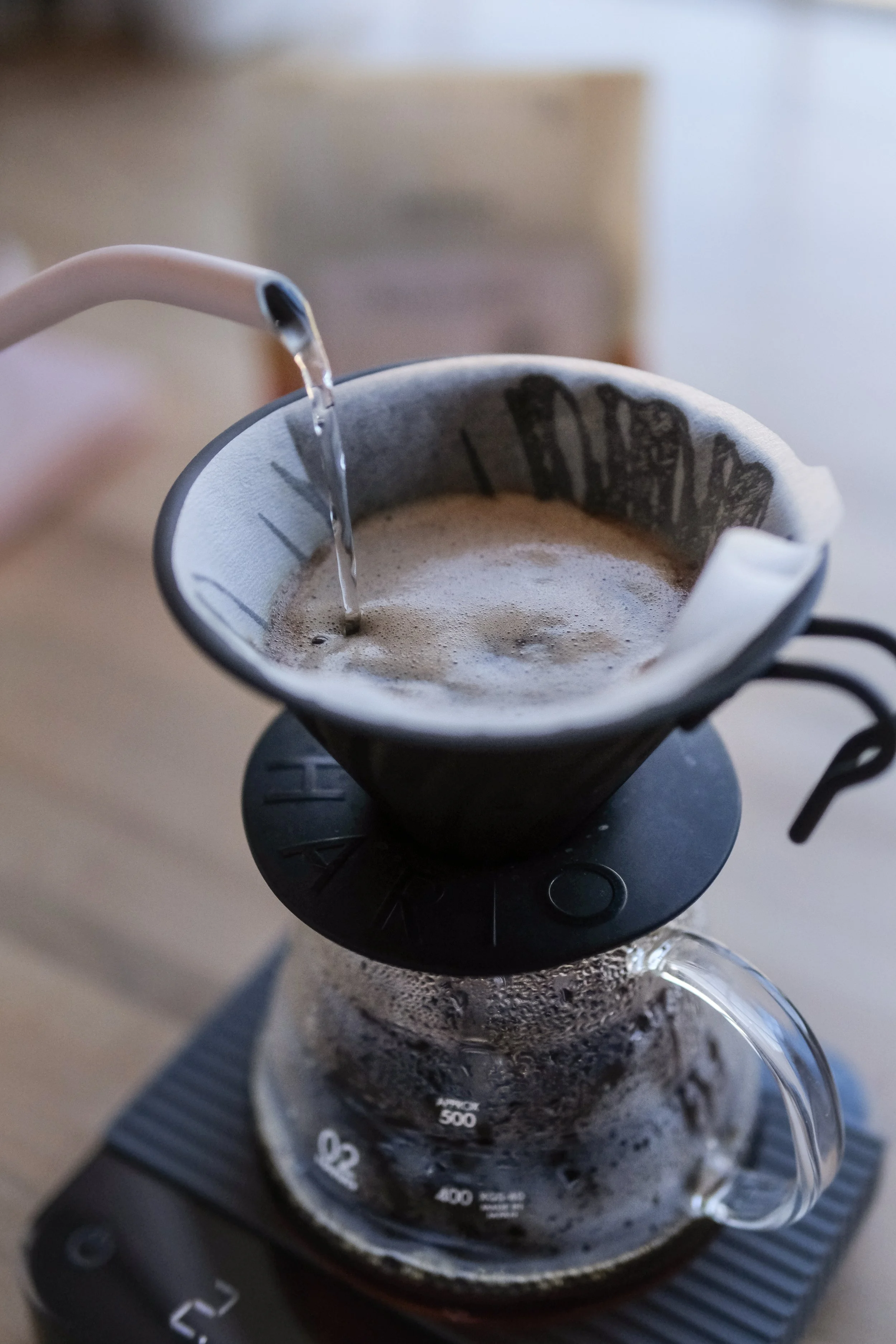Edison Coffee Brew Guide: the V60
Often imitated, rarely matched (we’re looking at you, Bodum), the Hario V60 is the gold standard for pour-over coffee. With unique cork-screwing ridges that provide airflow to expanding coffee grounds, and a single hole at the bottom of the cone-shaped brewer to enable your control of flow-rate, this brewer allows the coffee enthusiast a range of options for customizing the taste of their coffee. Despite all of its versatility, the V60 is nevertheless simple enough to learn. There are countless brewing techniques for the pour-over, but we’ll go through our preferred method and explain why we value it. With practice and a working grasp of extraction theory, you will be able to use the V60 to achieve your coffee’s fullest potential!
Materials Needed:
Brewer: Hario offers a variety of V60 models, all based around the same design. A quick glance on their website lists ceramic, plastic, metal, and glass drippers, all in various colors. Each dripper extracts coffee in the same fashion, so do not be afraid to pick your poison.
Filters: The V60 requires a specific type of paper filter, which should be available wherever you purchase your dripper.
Grinder: Simply put, you will need an adjustable burr grinder. We recommend the Baratza Encore. Hario’s ceramic hand grinder will also work well if you need a cheaper option, though your range of grind settings may be limited. Even still, it is capable of yielding a grind sufficient for most pour-over recipes.
Kettle: For precision’s sake, we use a particular type of kettle called a gooseneck, named after the kettle’s long, thin spout. There are a variety of brands that sell gooseneck kettles, which range from stovetop kettles to electric kettles that allow for temperature adjustment. Personally, we think that comfortability and ease-of-pour matter more than temperature control, so we suggest finding a kettle that feels good to hold and pour for you. Bona Vita offers a variety of kettles, all of which work excellently. Fellow’s Stagg kettles may be in a higher price range, but we find the precision of their pour to be unmatched.
Scale: There is no need for anything fancy here: the preference would be to find a scale that reads at least one decimal place, but one could make do without, so long as their pours are careful enough.
A Time or Stopwatch: The stopwatch on your phone will suffice.
Water: We highly recommend using filtered water for your pour-overs. The V60 can produce flavors in coffee marked by high acidity, sweetness, and complex fruitiness. The water that you use should be able to keep these flavors on clear display for you when you’re drinking your coffee. Conversely, avoid using distilled water, which will not properly extract your coffee, resulting in bland flavors.
Coffee: Typically, medium-to-light roasted coffee works best for the V60. The dripper optimizes such coffees by brining their flavors out—on the flip side, it can overemphasize darker roasts, producing harsh-tasting cups.
Instructions:
Weigh out your coffee:
We tend to make pour-overs that use 22 grams of ground coffee and yield 12 oz (350 grams) of extracted (brewed) coffee. This makes a single-serving and uses a ratio of 1 gram of ground coffee to 15 grams of water.
Grind your coffee:
You should grind your coffee on a medium-fine setting; not quite as coarse as what you would grind your drip coffee on.
Heat up your water:
As a general rule, you want your water temperature to reach and stay at 200 degrees fahrenheit. Heat is a factor in coffee extraction, and water that is too hot runs the risk of over-extracting your coffee, producing a bitter taste. That being said, you may need to play with the temperature depending on your coffee and your grinder, as sometimes a higher temperature can give your grind an extra “boost” when it comes to extraction.
Place filter into dripper and pre-wet filter:
Doing this will both eliminate a papery flavor from the filter passing into your coffee and warm up your brewing vessel, allowing it to maintain heat during the brew time.
Pour coffee into filter and zero out on scale
Wow, look at that pour…
Begin the pour process:
Pour in a spiral motion, starting from the center and extending out clockwise. In order to keep the extraction rate consistent and long enough, you will pour in intervals of 30 seconds. The chart below shows the amount of coffee you should pour within each interval:
Time: :00 :30 1:00 1:30 2:00 2:30
Water poured: 50g 50g 50g 75g 75g 50g
Total coffee: 50g 100g 150g 225g 300g 350g
Your coffee should finish extracting around 3:30.
notes
The bloom: Regardless of your method, it’s important that you begin your pour with a bloom. The bloom is an initial light pour, no more than 50 grams, that is used to degas the CO2 that resides within the grounds. Our first interval in our method comprises the bloom, giving the coffee sufficient time for all of the gas to leave. Without the bloom, the CO2 stays within the grounds and renders the flavor sour.
Intervals: When coffee is brewing, it extracts sour, sweet and bitter flavors, in that order. This is why we pour more water in the middle phase of the brew than we do at the beginning or the end. The goal is to extract more of the sweeter notes of the coffee than the sour and bitter notes, so we make 75g pours at 1:30 and 2:00. That being said, sour and bitter compounds are still important to have in your coffee, as they are responsible for the acidity and body of a coffee respectively. The trick is to balance each of these three compounds properly so that no single one comes out too strongly.
Troubleshooting: If your coffee is tasting too sour or thin, this means that your coffee extracted too quickly, resulting in a process we call under-extraction. The opposite is called over-extraction and it leaves the coffee tasting bitter and ashy. You’ll want to fine your grind when encountering under-extraction, and coarsen it when you over-extract.
Your coffee may also taste flat and flavorless. This can mean that your coffee is too old. Try to buy and drink coffee within six weeks of its roast date!
Next Steps
The sky is the limit when it comes to the V60. Over the course of your brewing, we’d encourage you to test out its variables in order to see how they affect the final product. For example, how might pouring slowly over the bed of coffee compare with a heavy pour, close to the grounds’ surface? You might also wish to play with your ratios. We use a 1:16 ratio of coffee-to-water in our recipe. How might the taste change if you used less coffee, extending the ratio to 1:17? What about if you shortened it to 1:12 by using more coffee? The V60 can make the most out of any coffee so we encourage you to run wild with it, trying new coffees and new techniques, and taking notes in order to grow your skill. Happy brewing!





